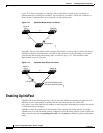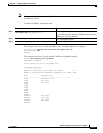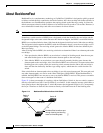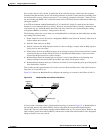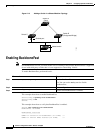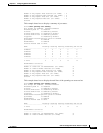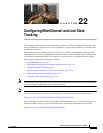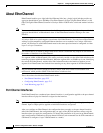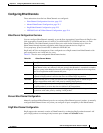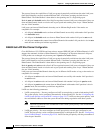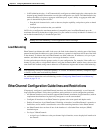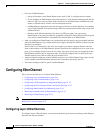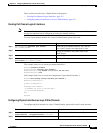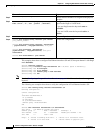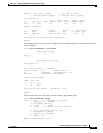
22-2
Software Configuration Guide—Release 15.0(2)SG
OL-23818-01
Chapter 22 Configuring EtherChannel and Link State Tracking
About EtherChannel
About EtherChannel
EtherChannel bundles up to eight individual Ethernet links into a single logical ink that provides an
aggregate bandwidth of up to 800 Mbps (Fast EtherChannel), 8 Gbps (Gigabit EtherChannel), or 80
Gbps (10 Gigabit EtherChannel) between a Catalyst 4500 or 4500X series switch and another switch or
host.
Note Because some linecards have a maximum bandwidth capacity toward the backplane, they can limit the
aggregate bandwidth of an Etherchannel when all the Etherchannel members belong to the same
linecard.
A Catalyst 4500 series switch supports a maximum of 64 EtherChannels. You can form an EtherChannel
with up to eight compatibly configured Ethernet interfaces across modules in a Catalyst 4500 series
switch. All interfaces in each EtherChannel must be the same speed and must be configured as either
Layer 2 or Layer 3 interfaces.
Note The network device to which a Catalyst 4500 series switch is connected may impose its own limits on
the number of interfaces in an EtherChannel.
If a segment within an EtherChannel fails, traffic previously carried over the failed link switches to the
remaining segments within the EtherChannel. When the segment fails, an SNMP trap is sent, identifying
the switch, the EtherChannel, and the failed link. Inbound broadcast and multicast packets on one
segment in an EtherChannel are blocked from returning on any other segment of the EtherChannel.
Note The port channel link failure switchover for the Catalyst 4500 series switch was measured at 50
miliseconds, which provides SONET-like link failure switchover time.
These subsections describe how EtherChannel works:
• Port Channel Interfaces, page 22-2
• Configuring EtherChannels, page 22-3
• Load Balancing, page 22-5
Port Channel Interfaces
Each EtherChannel has a numbered port channel interface. A configuration applied to the port channel
interface affects all physical interfaces assigned to that interface.
Note QoS does not propagate to members. The defaults, QoS cos = 0 and QoS dscp = 0, apply on the port
channel. Input or output policies applied on individual interfaces are ignored.
After you configure an EtherChannel, the configuration that you apply to the port channel interface
affects the EtherChannel; the configuration that you apply to the physical interfaces affects only the
interface where you apply the configuration. To change the parameters of all ports in an EtherChannel,
apply configuration commands to the port channel interface (such commands can be STP commands or
commands to configure a Layer 2 EtherChannel as a trunk).



